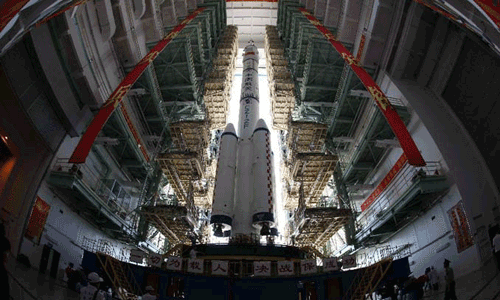China to launch first manned docking mission; will include first female astronaut
Country continues to take big steps with space program
China is days away from launching its first manned docking mission attempt to the country’s orbiting Tiangong-1 space station module.

The Shenzhou-9 manned spacecraft, the Long March-2F rocket, and the escape tower wait to be vertically transferred to the launch pad at the Jiuquan Satellite. (Photo: Xinhua)
According to China-based tabloid newspaper the Global Times , the China National Space Administration (CNSA) is now in the process of conducing final tests ahead of what’s looking to be a mid-June launch.
The manned spacecraft, referred to as “Shenzhou-9”, will be attached to a Long March-2F carrier rocket. They were moved to the launch platform at Jiuquan Satellite Launch Center in the Gobi Desert in northwest China this past weekend.
If the mission is successful, it could be a huge step for the country’s space program.
“It means China’s spacecraft will become a genuine manned shuttle tool between space and Earth. It can send human beings to space stations or space labs. This will be a significant step in China’s manned space flight history,” Zhou Jianping, chief designer of the manned space program.
Final tests
Up until time of launch, CNSA scientists will be conducting final tests on the spacecraft and rocket, along with joint tests between the astronauts, spacecraft, rocket, and ground systems. The Titangong-1 space station module, meanwhile, was lowered to docking orbit earlier this month.
According to sources, final preparations are running smoothly, and the three-selected astronauts have completed training and are physically and mentally prepared for the mission.
It should be noted that this trip will mark a historical milestone for the country, as it’ll be the first time China will send a female astronaut into space. According to China’s Xinhua news agency, it will be either Liu Yang or Wang Yaping (both candidates are from the Chinese Air Force’s Wuhan Flight Unit). The selected astronaut, along with her two travel partners, will join six male astronauts as the only Chinese nationals to travel into space.

Captain Wang Yaping (l) and Major Liu Yang. One of these women will join the Shenzhou-9 manned spacecraft docking mission. (Via: guardian.co.uk)
The mission
The docking mission is fairly simple: basically, the purpose of the program is to see if they can actually do it. The mission itself will be manually conducted by the astronauts, giving China a chance to fully test all of its docking technology.
Once docked to the Tiangong-1 space module lab, two of the astronauts will transfer over to the module while the other one remains on board the Shezhou-9 as a precautionary measure in case of emergency (a bit scary, no?).
Tiangong-1 Space Module Lab
The 9.4-ton Tiangon-1 module was launched on September 29, 2011, where it went into long-term operation mode awaiting dock attempts by the Shenzhou-9 and Shenzhou-10 (next mission). It completed China’s first space docking mission with the unmanned Shezhou-8 spacecraft in November.

Tiangon-1 module takes off from China. (Via: carnewschina.com)
It is scheduled to de-orbit in 2013 following the Senzhou-9 and -10 missions.
Tiangon-1 is not a fully developed space station; rather, it’s more so a testing platform for docking missions like the one coming up shortly. The CNSA hopes to eventually have a fully functioning space station under the agency’s Tiangon, or “Heavenly Palace,” program.
China’s space program outlook
This mission is big news for China. It’s also big news for the space exploration community as a whole, especially now that American and European space programs have slowed down their development due to limited funds.
The Chinese government has, of recent, spent billions of dollars to build the country’s space program. While it’s still viewed as being years behind the American and Russian programs, it’s moving perhaps fastest in terms of its achievements.
In 2003 it achieved its first successful human spaceflight, and in 2008 Chinese astronauts achieved their first spacewalk.

Fighter pilot Zhai Zhigang emerged from capsule to become first Chinese astronaut to walk in space. (Via: news.bbc.co.uk)
In December 2011, the Chinese government announced a five-year plan for space exploration. Details of this announcement included information as to how the government intends to draw on military and civilian resources to reach all of its goals, the likes of which include launching the aforementioned fully-functional space lab as well as collecting samples from the moon by 2016.
The latter goal, in particular, drew considerable attention as it had previously been stated by the government that they hoped to complete their first lunar exploration mission by 2020.
By the way things are progressing for the CNSA, this may end up being even sooner than later. ■
Via: GlobalTimes.cn
Advertisement
Learn more about Electronic Products Magazine





